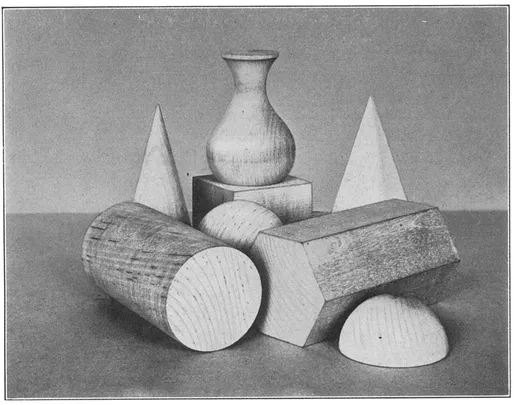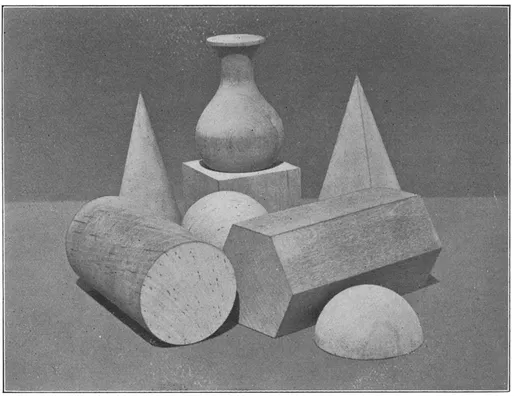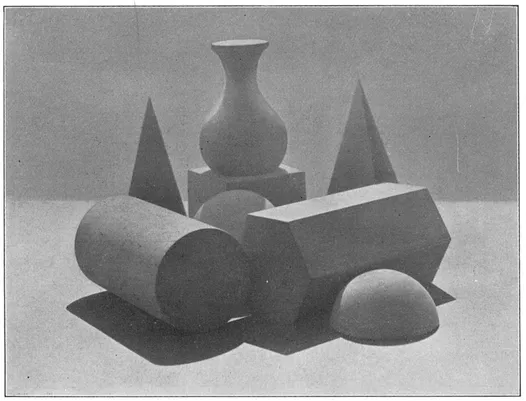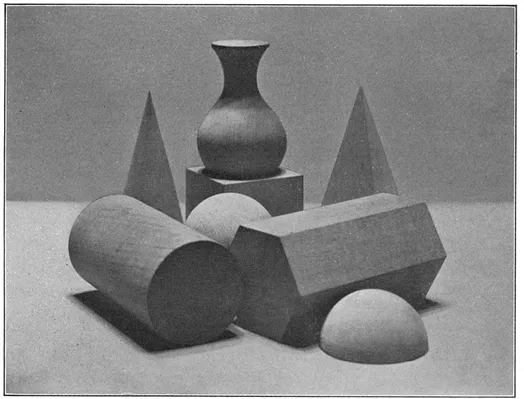
- 80 pages
- English
- ePUB (mobile friendly)
- Available on iOS & Android
eBook - ePub
Light, Shade and Shadow
About this book
During the first half of the twentieth century, E. L. Koller wrote a series of art instruction books for home study, designed to simplify various techniques for beginning artists — and help established artists polish their craft. The books are as relevant — and the information as essential — to artists today as it was then. A classic in this series, Light, Shade and Shadow, shows how the study of light is a necessary foundation for creating an appealing work of art.
Even the most beautiful drawing can appear flat without shading. But with this expert guide, every artist can learn how to use shadow to add visual dimension and drama to their work, and to master techniques such as highlighting and gradation. Beginning with the basics — casting light on simple geometric shapes — and progressing to the human figure, these step-by-step techniques, illustrations, and exercises can show artists of all abilities how to achieve a new level of depth in their work.
Even the most beautiful drawing can appear flat without shading. But with this expert guide, every artist can learn how to use shadow to add visual dimension and drama to their work, and to master techniques such as highlighting and gradation. Beginning with the basics — casting light on simple geometric shapes — and progressing to the human figure, these step-by-step techniques, illustrations, and exercises can show artists of all abilities how to achieve a new level of depth in their work.
Frequently asked questions
Yes, you can cancel anytime from the Subscription tab in your account settings on the Perlego website. Your subscription will stay active until the end of your current billing period. Learn how to cancel your subscription.
No, books cannot be downloaded as external files, such as PDFs, for use outside of Perlego. However, you can download books within the Perlego app for offline reading on mobile or tablet. Learn more here.
Perlego offers two plans: Essential and Complete
- Essential is ideal for learners and professionals who enjoy exploring a wide range of subjects. Access the Essential Library with 800,000+ trusted titles and best-sellers across business, personal growth, and the humanities. Includes unlimited reading time and Standard Read Aloud voice.
- Complete: Perfect for advanced learners and researchers needing full, unrestricted access. Unlock 1.4M+ books across hundreds of subjects, including academic and specialized titles. The Complete Plan also includes advanced features like Premium Read Aloud and Research Assistant.
We are an online textbook subscription service, where you can get access to an entire online library for less than the price of a single book per month. With over 1 million books across 1000+ topics, we’ve got you covered! Learn more here.
Look out for the read-aloud symbol on your next book to see if you can listen to it. The read-aloud tool reads text aloud for you, highlighting the text as it is being read. You can pause it, speed it up and slow it down. Learn more here.
Yes! You can use the Perlego app on both iOS or Android devices to read anytime, anywhere — even offline. Perfect for commutes or when you’re on the go.
Please note we cannot support devices running on iOS 13 and Android 7 or earlier. Learn more about using the app.
Please note we cannot support devices running on iOS 13 and Android 7 or earlier. Learn more about using the app.
Yes, you can access Light, Shade and Shadow by E. L. Koller in PDF and/or ePUB format, as well as other popular books in Art & Art Techniques. We have over one million books available in our catalogue for you to explore.
Information
LIGHT, SHADE, AND SHADOW
SOURCES AND KINDS OF ILLUMINATION
2. Main Sources of Light.—An examination of the wooden models will at once show that there are no absolute outlines in nature. The forms are expressed by various planes of light and shade coming together and the edges of these are seen simply because one plane is of a different tone value, that is, lighter or darker, than its neighbor. The values of these various planes are determined by the kind, the source, and the direction of the illumination that the objects receive.
Broadly considered, there are two general sources of light: sunlight, in which the rays of light are parallel, and artificial light, in which the rays of light come from a point and diverge.
The sunlight may be direct or indirect. The object may be directly in the path of the sun’s rays and thus be brilliantly lighted and cast clear distinct shadows; or it may simply receive light from a window that admits the reflected light from the outside lighted air; that is, the direct rays of the sun do not fall upon the object.
The artificial light may be of many kinds; from an arc or incandescent electric lamp, from a gas flame or burner, or from an oil lamp, a candle, an open-hearth fire, etc.
3. Kinds of Illumination.—Both sources of illumination may light up the objects in many ways. When the light is obtained from a number of directions at once, as from several windows or widely separated lamps, the illumination is known as diffused lighting.
When the source of light is in front of an object, so that the nearer parts of the object are lighted and the back is in shade, the illumination is known as front lighting.
When the source of light is behind an object, so that the back is lighted and the front is in shade, the illumination is known as rear lighting.
When the source of light is overhead, so that the tops of the objects are lighted, the illumination is known as overhead lighting.
When the source of light is on one side, so that the side of the object nearest the light is most brilliantly lighted and the opposite side is in shade, the illumination is known as side lighting.

FIG. 1
When the source of light is on the left side of and above the object, the illumination is known as conventional lighting.
The different kinds of illumination are here shown by means of photographs of the wooden models, but the actual effects caused by the different sources and directions of the light can best be studied by observing the results produced on the models when placed, singly and in groups, in every possible position.
4. Diffused Lighting.—In Fig. 1 are shown the effects produced by ordinary diffused lighting on the group of models. This is the effect that is produced when the models are placed on a table in a room well lighted by three or four windows; that is, with the light coming from three or four (or more) directions at one time. In this case, the light comes mostly from the front and sides but not from the back and there has been no particular effort made to secure interesting lights and shades. This group is introduced merely to show a typical condition of lighting, but reveals very little that would be clear enough to enable one to formulate principles of light and shade. No gradations of light and shade are shown, neither are there any well-marked shadows. This is due to the fact that the light comes from many sources and kills the greater portion of the shadows. For instance, the typical shadows might be cast toward the right by the light coming from the left, but as light is coming also from the right and from the front these latter rays shine in upon the shadows and, to a great degree, dispel them. Therefore, what little shadow is shown is directly under or very close to the object casting it, and it is very soft or blurred on the edges. The texture, that is the grain, of the wood of the models is beautifully revealed, thus showing that the lighting is clear and adequate.
It will be observed that, as a group, this effect of lighting is flat, monotonous, and far from pleasing, although it is perfectly natural and typical. The importance, therefore, of securing a method of lighting that will bring out properly the light, shade, and shadow effects is quite evident.
5. Front Lighting.—Fig. 2 shows the group of models lighted by direct sunlight coming from back of the observer and shining onto the front of the objects. The effects of surface lighting are interesting when comparison is made, object for object with the same group conventionally lighted, as in Fig. 5. On all the objects, deep shade is absent, because the strong front light dispels it, but a sort of half shade is noticeable on parts of each model. The high lights on all rounded surfaces tend to approach more nearly the center line instead of the left-hand contour of the object. If the models were of polished metal, the extremely brilliant points and lines of brightest high light would be clearly shown.
The shadows are clear and distinct, but little of them is seen because they are all cast back of the objects. However, should this group of models be looked at from above, the retreating shadows would be plainly seen.

FIG. 2
6. Rear Lighting.—The conditions of lighting for the group shown in Fig. 3 are exactly the reverse of those used for the group shown in Fig. 2, because the objects are lighted from the rear. As the light rays come toward the observer, they illuminate the backs of the models, put into deep shade the fronts of the objects, and cast dark, distinct shadows toward the observer. The most noticeable feature about this group is that, at first glance, it appears composed of black objects, with very little modeling, casting black shadows. Closer examination, however, reveals the modeling of each object, although largely in shade. With the exception of the top face of the hexagonal prism, which reflects the light rays perfectly, no high lights occur, although a few half lights are shown, as on the tops of the cylinder, the sphere, and the hemisphere. The soft graded lights on each side contour of the vase are beautiful examples of reflected light falling onto an object. The gradation of values from half light to half shade, and then from half shade to deep shade, as shown on the hemisphere, is worth careful study. The shadows are, of course, blacker than any of the deep shades, although careful observation is required to detect this at places. All shadows are cast toward the observer.

FIG. 3
7. Overhead Lighting.—When the models are lighted from above, as in Fig. 4, the most noticeable features are the bright lights on the tops of the objects and the dark shades at the bottom, the shadows being cast under the objects. In this way, high light, half tone, and shade are expressed, as in the case of the objects conventionally lighted, but from top to bottom, instead of from upper left to lower right. For instance, the high light on the sphere is exactly at the top and the half tone, if it could be seen, around the lower half, the shade being at the bottom. This is well illustrated by the lower part of the vase, which is practically a sphere. The very bright high light on the flat top of the vase shows very clearly the source of the light.
The shadows naturally have little extent beyond the limits of the objects themselves. The peculiar blurred effect of the edges of the shadows is due to the fact that, when the photograph was taken, the group was lighted from an overhead electric chandelier in which there were four or more lamps, each casting a shadow.

FIG. 4
8. Conventional Lighting.—In Fig. 5 is sh...
Table of contents
- Title Page
- Copyright Page
- Table of Contents
- PURPOSE
- LIGHT, SHADE, AND SHADOW
- MATERIALS AND METHODS OF WORK
- DRAWING EXERCISES